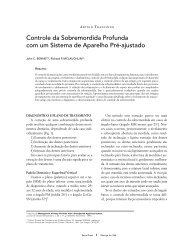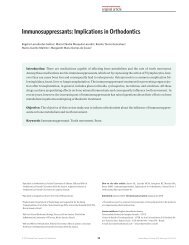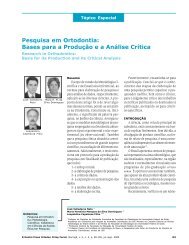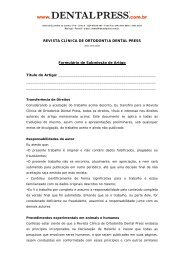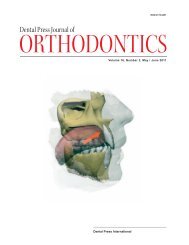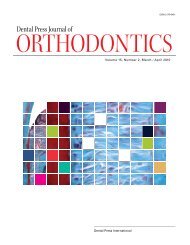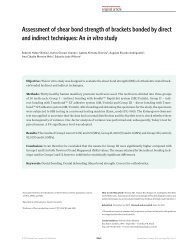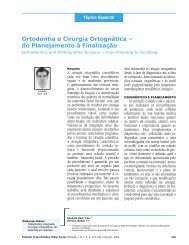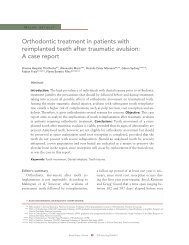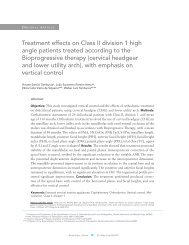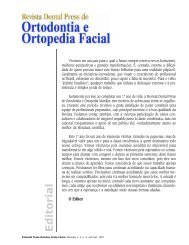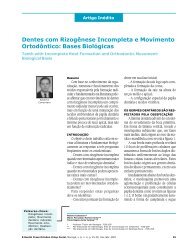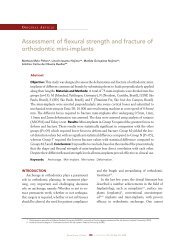Analysis of rapid maxillary expansion using Cone ... - Dental Press
Analysis of rapid maxillary expansion using Cone ... - Dental Press
Analysis of rapid maxillary expansion using Cone ... - Dental Press
Create successful ePaper yourself
Turn your PDF publications into a flip-book with our unique Google optimized e-Paper software.
O r i g i n a l A r t i c l e<strong>Analysis</strong> <strong>of</strong> <strong>rapid</strong> <strong>maxillary</strong> <strong>expansion</strong> <strong>using</strong><strong>Cone</strong>-Beam Computed TomographyGerson Luiz Ulema Ribeiro*, Arno Locks**, Juliana Pereira***, Maurício Brunetto***AbstractWhenever a <strong>maxillary</strong> arch is diagnosed as skeletally atresic the treatment <strong>of</strong> choice is usually<strong>maxillary</strong> orthopedic <strong>expansion</strong>, involving separation <strong>of</strong> the midpalatal suture. Basically, thissuture used to be assessed with the aid <strong>of</strong> a <strong>maxillary</strong> occlusal radiograph, which limited itsposteroanterior evaluation. Similarly, quantifying this atresia in cephalometric x-rays alwaysposed an obstacle for clinicians owing to considerable superimposition <strong>of</strong> facial structures. Withthe advent <strong>of</strong> computed tomography, this technology has revolutionized diagnostic methods indentistry because it provides high dimensional accuracy <strong>of</strong> the facial structures and a reliablemethod for quantifying the behavior <strong>of</strong> the <strong>maxillary</strong> halves, tooth inclination, bone formationat the suture in the three planes <strong>of</strong> space, as well as alveolar bone resorption and other consequences<strong>of</strong> palatal <strong>expansion</strong>.Keywords: Diagnosis. Radiographic images. Rapid <strong>maxillary</strong> <strong>expansion</strong>.<strong>Cone</strong>-Beam Computed Tomography.introductionRecovery <strong>of</strong> transverse <strong>maxillary</strong> discrepancyseems to be essential for the proper treatment<strong>of</strong> various types <strong>of</strong> malocclusion. Several authorshave investigated possible methods to expand the<strong>maxillary</strong> arch through different means. Proponents<strong>of</strong> <strong>rapid</strong> <strong>maxillary</strong> <strong>expansion</strong> (RME) arguethat this method causes minimum tooth movementand maximum skeletal displacement. Conversely,advocates <strong>of</strong> slow <strong>expansion</strong> believe thatthis method produces less tissue resistance inneighboring <strong>maxillary</strong> structures while enhancingbone formation in the inter<strong>maxillary</strong> suture, andthat these two factors help to minimize post<strong>expansion</strong>relapse. 12,13Some authors have advocated the separation<strong>of</strong> the midpalatal suture to expand narrow <strong>maxillary</strong>arches. 11,15,20 Moreover, Graber, 7 in 1972,asserted that this technique is in decline as itdevelops open bite, relapse and improves nasalbreathing only temporarily (REF). Furthermore,conventional orthodontic appliances have provedsuccessful in accomplishing intermolar and intercanine<strong>maxillary</strong> <strong>expansion</strong>.* M.Sc. and Ph.D. in Orthodontics, Rio de Janeiro Federal University (UFRJ). Pr<strong>of</strong>essor, Graduate and Postgraduate courses, UFSC. Diplomate, BrazilianBoard <strong>of</strong> Orthodontics and Facial Orthopedics.** M.Sc. and Ph.D. in Orthodontics, Rio de Janeiro Federal University (UFRJ). Postdoctoral research, University <strong>of</strong> Aarhus, Denmark. Pr<strong>of</strong>essor, Graduate andPostgraduate courses, UFSC. Diplomate, Brazilian Board <strong>of</strong> Orthodontics and Facial Orthopedics.*** Specialist in Orthodontics, UFSC. M.Sc. Candidate in Orthodontics, UFSC.<strong>Dental</strong> <strong>Press</strong> J Orthod 107 2010 Nov-Dec;15(6):107-12
<strong>Analysis</strong> <strong>of</strong> <strong>rapid</strong> <strong>maxillary</strong> <strong>expansion</strong> <strong>using</strong> <strong>Cone</strong>-Beam Computed TomographyGiven the diversity <strong>of</strong> structures comprisedin the crani<strong>of</strong>acial complex various therapeuticresources have emerged which are capable <strong>of</strong>modifying the position or morphology <strong>of</strong> thesecomponents. Lateral <strong>maxillary</strong> atresia is a verycommon condition in different malocclusions.This transverse deficiency, caused by genetic and/or functional 4 factors, may involve only the posteriordental segments, imparting excessive lingualtipping to these segments, 6 but it may alsobe associated with a skeletally compromisedmaxilla, which gives it a sicatréo appearance. 6,14When this happens, the maxilla presents with anarrow 6 and gothic palate. 14 To remedy this situation,an <strong>expansion</strong> is required which is capable<strong>of</strong> effecting maximum orthopedic movement <strong>of</strong>the <strong>maxillary</strong> bones while maintaining the integrity<strong>of</strong> the tissues and reducing the resulting toothinclination. 1,4,12,13,15,17,25 Rapid <strong>maxillary</strong> <strong>expansion</strong>(RME) meets these requirements, restoringthe transverse dimensions <strong>of</strong> this bone structureand corresponding dental arch 14,25 by opening themidpalatal suture in conjunction with orthopedicreactions in other facial sutures and slight movementsin the posterosuperior segments. 8Numerous studies have been conducted to investigatethe changes caused in the <strong>maxillary</strong> bonesand midpalatal suture as a result <strong>of</strong> <strong>rapid</strong> <strong>maxillary</strong><strong>expansion</strong>. Histological experiments on animalsshowed new bone formation in the suture zone afterpalate splitting. 5,10,28 Radiographic studies in humansshowed ossification in the region after <strong>expansion</strong>.However, the length <strong>of</strong> time that the palatal suturetakes to restore its normal structure in humans isstill the subject <strong>of</strong> considerable controversy. Thevast majority <strong>of</strong> authors recommend that retentionbe performed with the appliance itself, after palatesplitting, for a period <strong>of</strong> three months. 2,8,10,16,18,19,22The ability to measure these changes allowsorthodontists to predict the effects <strong>of</strong> orthopedictreatment. Invasive techniques such as metal implantsprovide accurate information but are tooaggressive for routine use. Histological control <strong>of</strong>tissue reactions is possible only in animal studiesor autopsy material. 27Several authors have studied the skeletal anddental changes resulting from opening the midpalatalsuture but the literature is still inconclusiveregarding dimensional changes in dentalarches and <strong>maxillary</strong> displacement as a whole, andwhether or not these changes are transient. 4,11,12,30According to Sato et al, 23 posteroanterior cephalometricradiography provides an assessment <strong>of</strong>the transverse dimensions <strong>of</strong> the face by broadeningthe scope and thus facilitating the diagnosis <strong>of</strong>crossbites and orthopedic changes inherent in the<strong>rapid</strong> opening <strong>of</strong> the midpalatal suture. Becauseit is an image in two dimensions, radiographicoverlays <strong>of</strong> anatomical structures hamper the preciselocation <strong>of</strong> cephalometric landmarks, whichare instrumental for diagnosing and assessing themaxilla before or after any intervention, notablyin the <strong>maxillary</strong> middle third. 9Assessment <strong>of</strong> frontal radiographs shows thatthe <strong>maxillary</strong> bones are displaced laterally withthe fulcrum located close to the fronto<strong>maxillary</strong>suture while lower skeletal <strong>expansion</strong> progresses.The <strong>maxillary</strong> central incisors usually move mesiallyand, in general, undergo uprighting after appliancestabilization. Such movement aids in closingthe wide median diastema produced by theorthopedic effects <strong>of</strong> the appliance. As these teethare uprighted, part <strong>of</strong> the arch length benefitsobtained with the <strong>expansion</strong> is lost. The occlusalradiograph shows that the inter<strong>maxillary</strong> sutureexperiences a non-parallel opening accompaniedby a further, V-shaped <strong>expansion</strong>, greater in theanterior than in the posterior region. 30In frontal view, a pyramid appears in the region<strong>of</strong> this suture, whose base is turned inferiorly.Thus, real bone mass gain occurs with a consequentincrease in arch perimeter. 4,10,11Occlusal radiographs have been widely usedfor monitoring the recovery <strong>of</strong> the suture afterpalatal separation. However, standardizing howx-rays are performed is not a simple matter.<strong>Dental</strong> <strong>Press</strong> J Orthod 108 2010 Nov-Dec;15(6):107-12
Ribeiro GLU, Locks A, Pereira J, Brunetto MThe occlusal view showed that in the anteroposteriordirection the opening <strong>of</strong> the suturewould be twice as large in the incisor than in themolar region, allowing the visualization <strong>of</strong> a newtriangle with the base facing the anterior region.Apparently, the amount <strong>of</strong> opening varies witheach individual. By comparing the opening <strong>of</strong> theinter<strong>maxillary</strong> suture with the dental effects it wasfound that the amount <strong>of</strong> suture separation wouldbe equal to or less than the amount <strong>of</strong> <strong>expansion</strong>in the dental arch. 10The advent <strong>of</strong> <strong>Cone</strong>-Beam Computed Tomography(CBCT) has made possible three-dimensionalassessment. Today, it is increasingly appliedin dentistry mainly because it is more affordableand entails lower radiation exposure. 9To compare the biological effects <strong>of</strong> radiationon various parts <strong>of</strong> the body, effective equivalentdose is used, which yields a comparison <strong>of</strong> the biologicaleffects <strong>of</strong> different types <strong>of</strong> ionizing radiationand allows adjustments to be made in the volumeand radiosensitivity <strong>of</strong> irradiated tissue. Theunit <strong>of</strong> measure used is the sievert (Sv). 9,24The effective equivalent dose in conventionalradiographic examinations, comprising3 <strong>maxillary</strong> periapical radiographs (5 µSv), 3mandibular periapical radiographs to assess thebone tissue available in the mandibular symphysis(5 µSv), 1 upper occlusal radiograph (4 µSv),1 panoramic radiograph (7 µSv), 1 posteroanteriorcephalometric radiograph (7 µSv), 1 lateralcephalometric radiograph (7 µSv), resultsin a total <strong>of</strong> 42 µSv. 9,24 Using a <strong>Cone</strong>-Beam CTscanner such as the i-CAT, radiation exposure isapproximately 30-100 µSv for examining boththe maxilla and mandible, which represents areduction <strong>of</strong> 1/6 in patient radiation exposurecompared to a conventional medical CT scanner(helical). <strong>Cone</strong>-Beam CT radiation dose issimilar to the radiation dose used in the periapicalexamination <strong>of</strong> the entire mouth, equivalentto approximately 4-15 times the dose <strong>of</strong> a panoramicX-ray. 9Moreover, compared to conventional radiography,the potential <strong>of</strong> CT to provide additionalinformation is much higher. Additionally, with<strong>Cone</strong>-Beam CT, pr<strong>of</strong>essionals can obtain reconstructions<strong>of</strong> all conventional dental radiographsin addition to the unique information provided bymultiplanar and 3D reconstructions. 9As new knowledge is generated by three-dimensionalviews <strong>of</strong> the skull and face, <strong>Cone</strong>-BeamCT is expected to change concepts and shift paradigms,redefining goals and treatment plans in orthodontics.This would facilitate the diagnosis <strong>of</strong><strong>maxillary</strong> atresia and <strong>maxillary</strong> behavior in terms<strong>of</strong> <strong>expansion</strong> procedures, thus allowing for quantification<strong>of</strong> the actual skeletal gains in dealing withtwo different activation protocols. CT will thereforecontribute to diagnosis to the extent that itwill be decisive in establishing the best protocol<strong>expansion</strong> to be used in treatment planning. 9DISCUSSIONThe increase noted in upper arch transverse dimensionsafter <strong>rapid</strong> <strong>maxillary</strong> <strong>expansion</strong> (RME)is due mainly to orthopedic effects, implying a realgain in bone mass and dental arch perimeter, as illustratedin Figures 1 and 2. Besides providing anexpected increase in dental arch width, the Haas<strong>expansion</strong> appliance provides high palatal <strong>expansion</strong>,which translates into a significant transverseincrease in the deep region <strong>of</strong> the palate. Clearclinical evidence <strong>of</strong> separation <strong>of</strong> the <strong>maxillary</strong>processes is given through a gradual opening <strong>of</strong> thediastema between the <strong>maxillary</strong> central incisors,observed in Figure 3. After the third completeturn <strong>of</strong> the screw, the incisors are affected by <strong>rapid</strong><strong>maxillary</strong> <strong>expansion</strong>. From this stage on, a directrelationship takes place between the magnitude<strong>of</strong> the open diastema and the amount <strong>of</strong> orthopediceffect induced by the <strong>expansion</strong>. It is thereforepossible to perform a clinical interpretation<strong>of</strong> skeletal involvement during RME: The largerthe diastema, the greater the induced orthopediceffect. After <strong>expansion</strong> screw stabilization the<strong>Dental</strong> <strong>Press</strong> J Orthod 109 2010 Nov-Dec;15(6):107-12
<strong>Analysis</strong> <strong>of</strong> <strong>rapid</strong> <strong>maxillary</strong> <strong>expansion</strong> <strong>using</strong> <strong>Cone</strong>-Beam Computed Tomographycentral incisors returned spontaneously to theiroriginal position. Control over this now purelyorthodontic movement is linked to the memory <strong>of</strong>stretched gingival fibers, which <strong>rapid</strong>ly move, firstthe crowns, then the roots, closer to each other.Total <strong>maxillary</strong> occlusal x-rays are the routinediagnostic tool used in orthodontic practice to verifyand document suture separation. <strong>Cone</strong>-Beamcomputed tomography enables more accurate resultevaluation and improved quantification. Onecan observe a triangular, radiolucent area withits base facing the anterior nasal spine, a regionwhere bone strength is reduced (Figs 2 and 3). Atthe same time that CT confirms the orthopedicsplitting <strong>of</strong> the maxilla, it subsequently recordsmidpalatal suture reorganization, which occursduring the retention phase, when the applianceis kept in the mouth (Fig 4). The fixed expandershould only be replaced by a removable retentionplate after complete tomographic restructuring,which takes on average 3-4 months. 29It seems indisputable that, even though thepredominant effect is <strong>of</strong> an orthopedic nature,orthodontic effect, represented by the flaring <strong>of</strong> theposterior teeth and alveolar process, is an integralpart <strong>of</strong> <strong>rapid</strong> <strong>maxillary</strong> <strong>expansion</strong>. It is known topractitioners who deal with orthopedic <strong>expansion</strong>that hand in hand with the gradual opening <strong>of</strong> themidpalatal suture, the force delivered by the expandercauses periodontal ligament compression,lateral tipping <strong>of</strong> the alveolar process and subsequentflaring <strong>of</strong> the posterior teeth. These changesrepresent the orthodontic effect <strong>of</strong> RME. Butbefore these forces induce classical orthodonticmovement with osteoclastic histological changes inthe periodontium, the <strong>maxillary</strong> bones are split dueto orthopedic effects (Figs 2 and 3).The ratio between orthopedic and orthodonticeffects derived from <strong>rapid</strong> <strong>maxillary</strong> <strong>expansion</strong>depends mainly on bone strength, which increaseswith age. As a general rule, effects on thebasal bone tend to be significant in children andminimal, or even non-existent, after the growthphase. As patient age increases, orthodontic effectswill be increasingly more prevalent thanorthopedic effects. 21FIGure 1 - Three-dimensional occlusal reconstruction <strong>of</strong> the maxilla froma CT scan, showing the closed midpalatal suture.FIGure 2 - Three-dimensional occlusal reconstruction <strong>of</strong> the maxilla froma CT scan, showing the open midpalatal suture.<strong>Dental</strong> <strong>Press</strong> J Orthod 110 2010 Nov-Dec;15(6):107-12
Ribeiro GLU, Locks A, Pereira J, Brunetto MABFIGure 3 - Three-dimensional occlusal reconstruction <strong>of</strong> the maxilla from a CT scan, showing the open midpalatal suture: (A) posteroanterior view; (B) occlusalview.ABFIGure 4 - Three-dimensional occlusal reconstruction <strong>of</strong> the maxilla from a CT scan, showing the suture reorganization process: (A) posteroanterior view;(B) occlusal view.CONCLUSIONSIt could be argued that nowadays orthopedic<strong>maxillary</strong> <strong>expansion</strong> is part and parcel <strong>of</strong>a coherent therapeutic approach in orthodonticpractice, provided that <strong>maxillary</strong> atresia ispresent. The lateral repositioning <strong>of</strong> the maxillaand increased basal bone, which can beaccurately observed in <strong>Cone</strong>-Beam computedtomography confirms the marked morphologicalchanges that occur in the upper arch andnaso<strong>maxillary</strong> structure.In general, the decision to provide orthodontictreatment <strong>using</strong> palate-splitting mechanicswill depend on the clinical experience <strong>of</strong> eachorthodontist, the need for such procedure andthe individual characteristics <strong>of</strong> each patient,<strong>Dental</strong> <strong>Press</strong> J Orthod 111 2010 Nov-Dec;15(6):107-12
<strong>Analysis</strong> <strong>of</strong> <strong>rapid</strong> <strong>maxillary</strong> <strong>expansion</strong> <strong>using</strong> <strong>Cone</strong>-Beam Computed Tomographysuch as age. These variables will establish theorthodontic planning and treatment best suitedfor each case.<strong>Cone</strong>-Beam Computed Tomography is agroundbreaking diagnostic method in dentistryas it provides high dimensional accuracy <strong>of</strong> thefacial structures and a reliable method for quantifyingthe behavior <strong>of</strong> the <strong>maxillary</strong> halves,dental tipping, bone formation at the suturein the three planes <strong>of</strong> space, as well as alveolarbone resorption and other consequences <strong>of</strong>palatal <strong>expansion</strong>.ReferEncEs1. Bell RA. A review <strong>of</strong> <strong>maxillary</strong> <strong>expansion</strong> in relation to rate <strong>of</strong><strong>expansion</strong> and patient’s age. Am J Orthod. 1982 Jan;81(1):32-7.2. Belli SJ. Long term anteroposterior, transverse and verticalskeletal changes following <strong>rapid</strong> <strong>maxillary</strong> <strong>expansion</strong> in adults[thesis]. Columbus (Ohio): The Ohio State University; 1992.3. Biederman W. A hygienic appliance for <strong>rapid</strong> <strong>expansion</strong>.J Pract Orthod. 1968 Feb;2(2):67-70.4. Bishara SE, Staley RN. Maxillary <strong>expansion</strong>: clinical implications.Am J Orthod Dent<strong>of</strong>acial Orthop. 1987 Jan;91(1):3-14.5. Cleall JF, Bayne DI, Posen JM, Subtelny JD. Expansion <strong>of</strong> themidpalatal suture in the monkey. Angle Orthod. 1965 Jan;35:23-35.6. Dipaolo RJ. Thoughts on palatal <strong>expansion</strong>. J Clin Orthod.1970 Sep;4(9):493-7.7. Graber TM. Orthodontics principles and practice. 3 rd ed.Philadelphia: WB Saunders; 1972, 953p.8. Ekström C, Henrikson CO, Jensen R. Mineralization in themidpalatal suture after orthodontic <strong>expansion</strong>. Am J Orthod.1977 Apr;71(4):449-55.9. Garib DG, Raymundo R Jr, Raymundo MV, RaymundoDV, Ferreira SN. Tomografia computadorizada de feixecônico (cone beam): entendendo este novo método dediagnóstico por imagem com promissora aplicabilidade naOrtodontia. Rev <strong>Dental</strong> <strong>Press</strong> Ortod Ortop Facial. 2007 marabr;12(2):139-56.10. Haas AJ. Rapid <strong>expansion</strong> <strong>of</strong> the <strong>maxillary</strong> dental arch andnasal cavity by opening the midpalatal suture. Angle Orthod.1961 Apr;31(2):73-90.11. Haas AJ. The treatment <strong>of</strong> <strong>maxillary</strong> deficiency by opening themidpalatal suture. Angle Orthod. 1965 Jul:35(3):200-17.12. Haas AJ. Palatal <strong>expansion</strong>: just the beginning <strong>of</strong> dent<strong>of</strong>acialorthopedics. Am J Orthod. 1970 Mar;57(3):219-55.13. Herold JS. Maxillary <strong>expansion</strong>: a retrospective study <strong>of</strong> threemethods <strong>of</strong> <strong>expansion</strong> and their long-term sequelae. Br JOrthod. 1989 Aug;16(3):195-200.14. Hershey HG, Stewart BL,Warren DW. Changes in nasal airwayresistance associated with <strong>rapid</strong> <strong>maxillary</strong> <strong>expansion</strong>. Am JOrthod. 1976 Mar;69(3):274-84.15. Isaacson RJ, Ingram AH. Forces produced by <strong>rapid</strong> <strong>maxillary</strong><strong>expansion</strong>. II. Forces present during treatment. Angle Orthod.1964 Oct;34(4):261-70.16. Inoue N, Oyama K, Ishiguro K, Azuma M, Ozaki T. Radiographicobservation <strong>of</strong> <strong>rapid</strong> <strong>expansion</strong> <strong>of</strong> human maxilla. Bull TokyoMed Dent Univ. 1970 Sep;17(3):249-61.17. Goddard CL. Discussion: separation <strong>of</strong> the superior maxilla atthe symphysis. <strong>Dental</strong> Cosmos. 1893 Sep;35(9):882-2.18. Melsen B. A histological study <strong>of</strong> the influence <strong>of</strong> suturalmorphology and skeletal maturation on <strong>rapid</strong> palatal <strong>expansion</strong>in children. Trans Eur Orthod Soc. 1972:499-507.19. Moss JP. Rapid <strong>expansion</strong> <strong>of</strong> the <strong>maxillary</strong> arch. Part II. J ClinOrthod. 1968 May;2(5):215-23.20. Murphy JJ. A histological study <strong>of</strong> crani<strong>of</strong>acial sutures heldin long retention following <strong>rapid</strong> palatal <strong>expansion</strong> in rhesusmonkeys [thesis]. Ohio: The Ohio State University; 1975.21. Ribeiro GLU, Retamoso LB, Moschetti AB, Mei RMS, CamargoES, Tanaka OM. Palatal <strong>expansion</strong> with six bands: an alternativefor young adults. Rev Clín Pesq Odontol. 2009 jan-abr; 5(1):61-6.22. Sandikçioglu M, Hazar S. Skeletal and dental changes after<strong>maxillary</strong> <strong>expansion</strong> in the mixed dentition. Am J OrthodDent<strong>of</strong>acial Orthop. 1997 Mar;111(3):321-7.23. Sato K, Vigorito JW, Carvalho LS. Avaliação cefalométricada disjunção rápida da sutura palatina mediana através datelerradiografia em norma frontal. Ortodontia.1986 jandez;19(1/2):44-51.24. Scarfe WC, Farman AG, Sukovic P. Clinical applications <strong>of</strong>cone-beam computed tomography in dental practice. J CanDent Assoc. 2006 Feb;72(1):75-80.25. Silva Filho OG, Valladares Neto J, Rodrigues AR. Earlycorrection <strong>of</strong> posterior crossbite: biomechanical characteristics<strong>of</strong> the appliances. J Pedod. 1989 Spring;13(3):195-221.26. Silva Filho OG, Boas MC, Capelozza Filho L. Rapid<strong>maxillary</strong> <strong>expansion</strong> in the primary and mixed dentitions: acephalometric evaluation. Am J Orthod Dent<strong>of</strong>acial Orthop.1991 Aug;100(2):171-9.27. Souza MMG. Comportamento radiográfico, histológico ehistométrico da sutura palatina mediana de primatas adultos(Cebus apella) submetidos à expansão maxilar [tese]. Rio deJaneiro (RJ): Universidade Federal do Rio de Janeiro; 1992.28. Starnbach H, Bayne D, Cleall J, Subtelny JD. Facioskeletalchanges resulting from <strong>rapid</strong> <strong>maxillary</strong> <strong>expansion</strong>. AngleOrthod. 1966 Apr;36(2):152-64.29. Orlando T, Bruno O, Gerson R. Detalhes singulares nosprocedimentos operacionais da disjunção palatal. Rev <strong>Dental</strong><strong>Press</strong> Ortod Ortop Facial. 2004 jul-ago;9(4):98-107.30. Wertz RA. Skeletal and dental changes accompanying <strong>rapid</strong>midpalatal suture opening. Am J Orthod. 1970 Jul;58(1):41-66.Submitted: July 2010Revised and accepted: August 2010Contact addressGerson Luiz Ulema RibeiroRua Max Colin, 1356CEP: 89.204-635 – Joinville / SC, BrazilE-mail: gersonlr@expresso.com.br<strong>Dental</strong> <strong>Press</strong> J Orthod 112 2010 Nov-Dec;15(6):107-12



